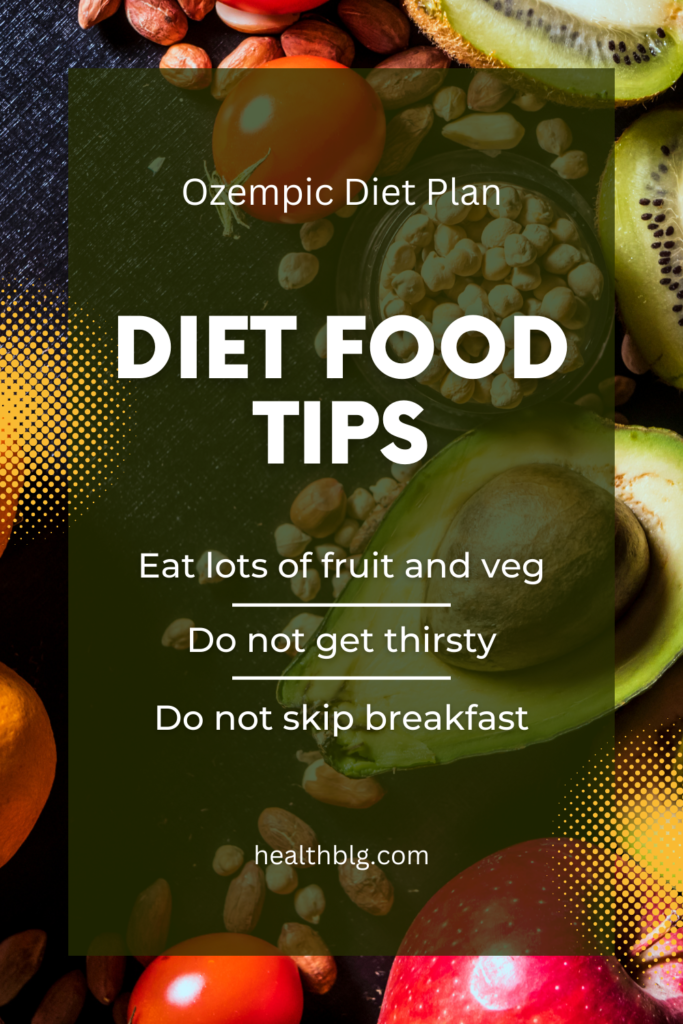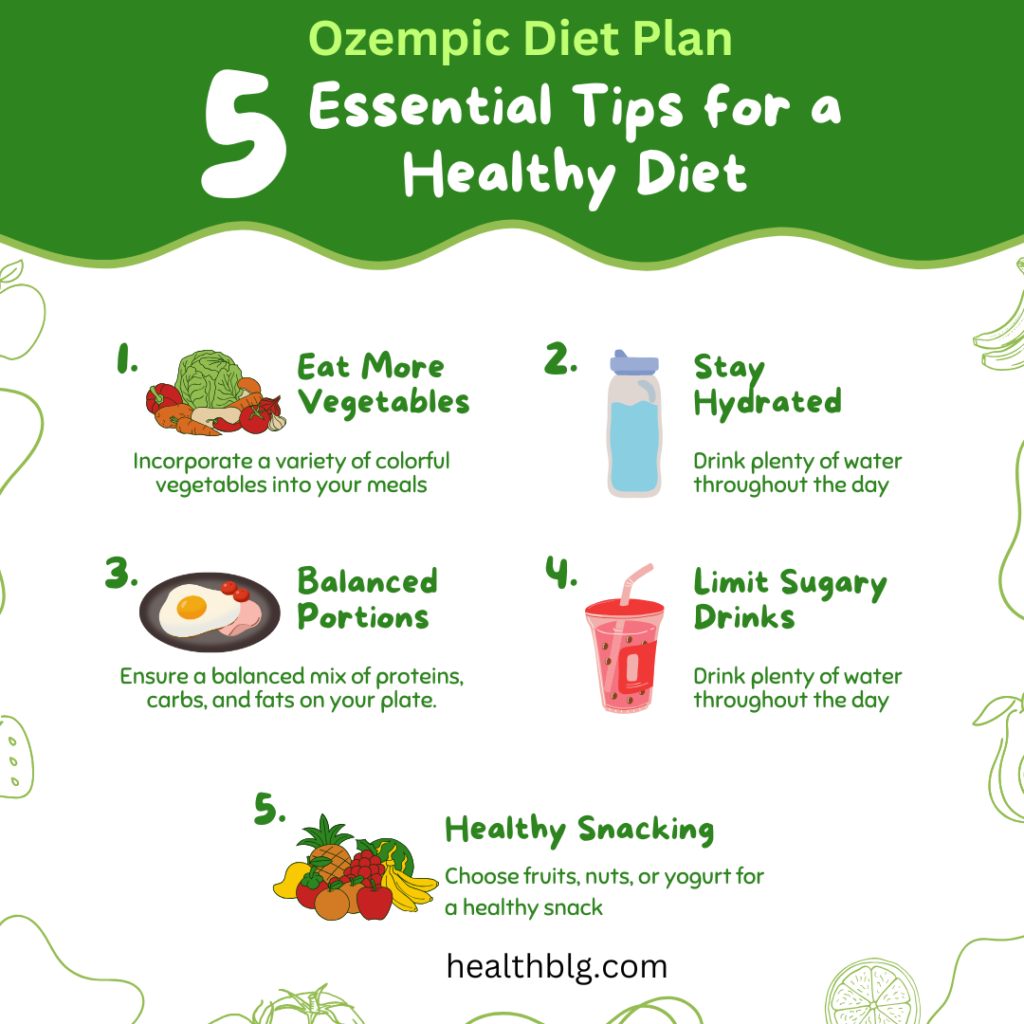Ozempic, a medication originally developed for managing type 2 diabetes, has become widely recognized for its effectiveness in promoting weight loss. Since its approval by the U.S. Food and Drug Administration (FDA) in 2021 for weight management, it has garnered attention from healthcare professionals and patients alike. Ozempic (semaglutide) works by mimicking a hormone that helps regulate insulin levels, appetite, and digestion. It can help people lose weight by reducing hunger and increasing feelings of fullness. However, Ozempic should be paired with a healthy eating plan and lifestyle changes for optimal results.
This article will delve into the Ozempic diet plan, providing a comprehensive guide on maximising your Ozempic treatment. Whether using it for weight loss or managing type 2 diabetes, understanding how to structure your diet around Ozempic can maximize its benefits. We’ll cover the key principles of a healthy eating plan that complements this medication, food recommendations, meal planning tips, and lifestyle changes for long-term success.
What is Ozempic?
Ozempic is a prescription medication containing semaglutide, a glucagon-like peptide-1 (GLP-1) receptor agonist. It is commonly prescribed for people with type 2 diabetes to improve blood sugar control. However, in 2021, Ozempic was also approved for use as a weight-loss aid for overweight or obese individuals.
Ozempic works by:

- Increasing Insulin Sensitivity: It helps the body use insulin more effectively, lowering blood sugar levels.
- Reducing Appetite: It slows gastric emptying, reducing hunger and increasing satiety (fullness).
- Improving Blood Sugar Control: In addition to weight loss, Ozempic helps regulate blood sugar, making it beneficial for people with type 2 diabetes.
- Promoting Fat Loss: Ozempic overall affects appetite and metabolism, helping people reduce body fat, particularly abdominal fat.
Though Ozempic is often prescribed as part of a weight loss regimen, it works best with a healthy diet and regular physical activity. The goal is to lose weight and develop sustainable, long-term habits promoting well-being.
Why the Diet Matters with Ozempic
Ozempic can help with weight loss, but it does not guarantee results. To get the best possible outcomes, it’s crucial to complement the medication with a balanced, nutrient-dense diet. The medication’s appetite-suppressing effects mean that individuals may feel less hungry. However, focusing on the food quality is essential to ensure you get the right nutrients.
A healthy diet, rich in vegetables, lean proteins, whole grains, and healthy fats, is essential for optimal results. With Ozempic, many individuals notice reduced cravings and portion sizes, making it easier to stick to a more nutritious diet. However, making smart food choices will determine how well the medication supports weight loss or diabetes management goals.
Key Principles of the Ozempic Diet Plan
The Ozempic diet plan focuses on foods low in calories and nutrient-dense. When planning meals, aim for balance and sustainability. Below are the essential components of an Ozempic-friendly diet plan:
- Focus on Whole, Unprocessed Foods
Processed foods often contain added sugars, refined carbohydrates, unhealthy fats, and excess sodium, hindering your weight loss efforts. Instead, prioritize whole, minimally processed foods, including:
- Vegetables: Leafy greens, cruciferous vegetables (broccoli, cauliflower), and colourful vegetables like bell peppers, carrots, and tomatoes are high in fibre, vitamins, and minerals.
- Fruits: Opt for low-sugar fruits like berries, apples, and citrus. These provide fibre, antioxidants, and hydration.
- Whole Grains: Choose complex carbohydrates like brown rice, quinoa, barley, and oats. These foods are rich in fibre and help stabilize blood sugar.
- Lean Proteins: Include protein-rich foods like chicken, turkey, lean cuts of beef, tofu, tempeh, eggs, and fish, particularly fatty fish like salmon, which provides omega-3 fatty acids.
- Healthy Fats: Incorporate healthy fats like avocado, olive oil, nuts, seeds, and fatty fish to support satiety and overall health.
- Incorporate Balanced Macronutrients
The ideal Ozempic diet should focus on balanced macronutrients to provide lasting energy and promote fat loss:
- Proteins: Protein is essential for muscle preservation and repair, especially when losing weight. Aim for 20-30% of your daily calories from high-quality protein sources. This will help you feel full and maintain muscle mass.
- Healthy Fats: Fats are important for hormone regulation, brain health, and satiety. Include healthy fats to support weight loss and maintain energy levels. Aim for 20-35% of your daily calories from healthy fats.
- Carbohydrates: Carbohydrates, particularly from whole grains, fruits, and vegetables, provide energy. Aim to get 40-50% of your daily calories from healthy carbs to fuel your body without spiking blood sugar.
- Control Portions and Practice Mindful Eating
Since Ozempic helps curb appetite, portion control can become easier. However, it’s still essential to practice mindful eating. Pay attention to your hunger cues and avoid eating out of boredom or stress.
You can also use tools like portion-control plates or measuring cups to help gauge your food intake. The goal is not to overeat, even if you feel less hungry, as overeating can still hinder weight loss progress.
- Prioritize Fiber-Rich Foods
Fiber helps with digestion, promotes feelings of fullness, and stabilizes blood sugar. With Ozempic reducing your appetite, high-fibre foods can support satiety and help regulate your digestive system. Aim to include fibre-rich foods like:

- Vegetables: Leafy greens, cucumbers, zucchini, and bell peppers.
- Legumes: Beans, lentils, and chickpeas are excellent sources of fibre.
- Whole Grains: Brown rice, quinoa, oats, and barley.
- Fruits: Apples, pears, berries, and citrus fruits.
- Stay Hydrated
Drinking enough water is crucial for overall health and can also support weight loss. Aim to drink at least 8 cups (64 ounces) of water daily. Hydration is particularly important because Ozempic may cause mild dehydration, especially when used with other medications that affect fluid balance. Herbal teas and water-rich foods like cucumbers and watermelon can help keep you hydrated.
- Limit Processed and High-Sugar Foods
While Ozempic helps with appetite control, it’s still essential to limit foods that can sabotage weight loss and diabetes control. Avoid foods high in refined sugars, trans fats, and artificial sweeteners. Some examples of foods to limit or avoid:
- Sugary beverages (sodas, energy drinks, sweetened teas)
- Processed snacks (chips, cookies, candy)
- White bread and other refined grain products
- Fast food and deep-fried foods
- Exercise Regularly
While Ozempic can help you lose weight and regulate blood sugar, it works best with regular physical activity. Aim for at least 150 minutes of moderate aerobic exercise (e.g., walking, swimming, cycling) per week, in addition to strength training exercises twice a week. Exercise can help further reduce appetite, boost metabolism, and improve overall health.

Sample Ozempic Diet Plan
Here’s an example of a 3-day meal plan that follows the principles of a healthy, balanced diet while complementing the effects of Ozempic:
Day 1
- Breakfast: Scrambled eggs with spinach and tomatoes, topped with avocado slices; black coffee or herbal tea.
- Lunch: Grilled chicken breast with quinoa, roasted Brussels sprouts, and a mixed green salad with olive oil and balsamic vinegar dressing.
- Snack: A small handful of almonds and a few slices of cucumber.
- Dinner: Baked salmon with steamed broccoli and a side of sweet potato.
- Drink: Water, herbal tea, or black coffee.
Day 2
- Breakfast: Greek yoghurt with chia seeds, berries, and a sprinkle of cinnamon.
- Lunch: Grilled turkey and avocado wrap with whole-grain tortilla, mixed greens, and mustard.
- Snack: A small apple with a tablespoon of almond butter.
- Dinner: Stir-fried tofu with vegetables (broccoli, bell peppers, carrots) and brown rice.
- Drink: Water, herbal tea, or black coffee.
Day 3
- Breakfast: Oatmeal with ground flaxseed, almond milk, and a few banana slices.
- Lunch: Tuna salad with leafy greens, olive oil, and lemon dressing served with whole-grain crackers.
- Snack: A hard-boiled egg and a handful of baby carrots.
- Dinner: Grilled shrimp with a side of roasted cauliflower and quinoa.
Drink: Water, herbal tea, or black coffee.

Conclusion: Achieving Success with Ozempic
Incorporating Ozempic into your weight loss or diabetes management plan can lead to significant benefits, but it’s essential.
<script type="application/ld+json">
{
"@context": "https://schema.org",
"@type": "Article",
"mainEntityOfPage": {
"@type": "WebPage",
"@id": "https://healthblg.com/ozempic-diet-plan/"
},
"headline": "Ozempic Diet Plan: A Comprehensive Guide for Success",
"description": "Ozempic Diet Plan: A Comprehensive Guide for Success",
"image": "https://healthblg.com/wp-content/uploads/2024/11/Ozempic-Diet-Plan-2-683x1024.png",
"author": {
"@type": "",
"name": ""
},
"publisher": {
"@type": "Organization",
"name": "",
"logo": {
"@type": "ImageObject",
"url": ""
}
},
"datePublished": ""
}
</script>









